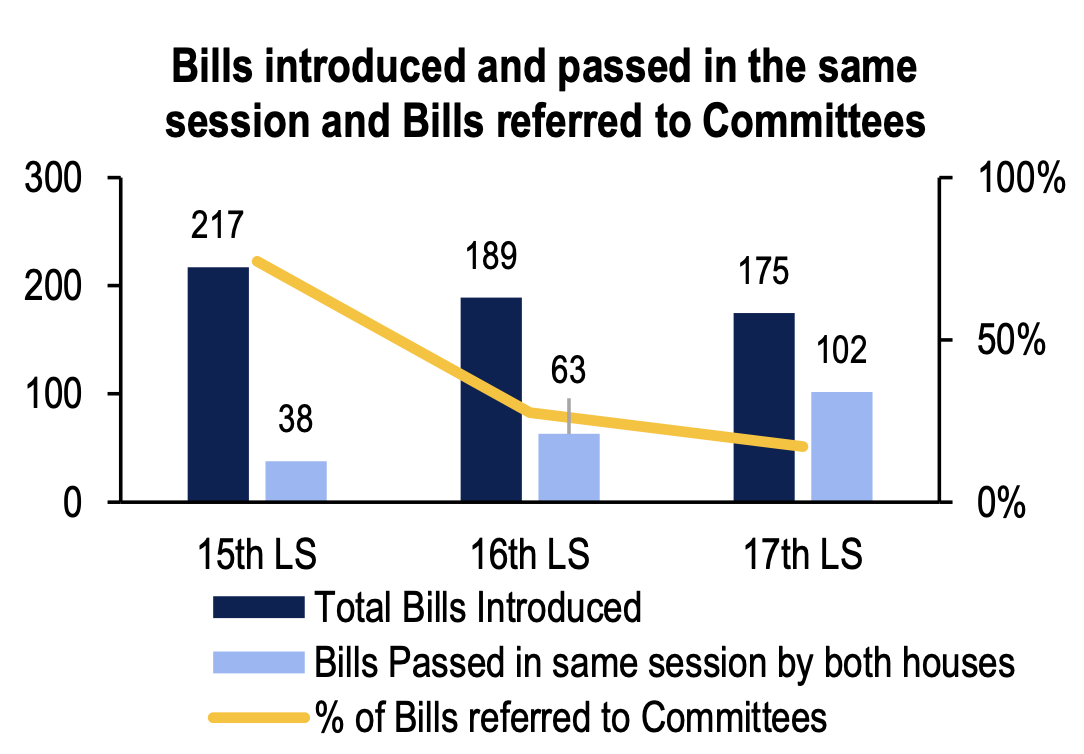All the Vital Stats About Parliament’s Monsoon Session
The Monsoon Session of 2023 was held from July 20, 2023 to August 11, 2023. Lok Sabha functioned for 43% of its scheduled time and Rajya Sabha functioned for 55%. Twenty-three Bills were passed during this session. This session also saw the discussion on the first no-confidence motion of the 17th Lok Sabha.
56% of Bills introduced in this session passed; three referred to Standing Committees

Photo: PRS Legislative Research
- This session saw high legislative activity despite Parliament working for just half of its scheduled time. Most Bills were passed with little scrutiny. 56% of Bills introduced in this session were passed by both Houses. On average, a Bill introduced in this session was passed within eight days of introduction.
- For example, Bills expanding the discretionary powers of the LG in Delhi, allowing for mining of strategic minerals like lithium, and regulating personal data were passed by Parliament within seven days of introduction. The Anusandhan National Research Foundation Bill, 2023 was passed within five days of introduction.
- Out of 25 Bills introduced, three have been referred to committees. In this Lok Sabha, so far, 17% Bills have been referred to Committees. This is lower as compared to the last three Lok Sabhas. Of the 23 Bills passed in this session, seven have been examined by Standing Committees.

Photo: PRS Legislative Research
- Lok Sabha passed 22 Bills in this session. 20 of these Bills were discussed for less than an hour before passing. Nine Bills, including the IIM (Amendment) Bill, 2023 and Inter-Services Organisation Bill 2023, were passed within 20 minutes in Lok Sabha. The Bills to create the National Nursing and Midwifery Commission and the National Dental Commission were discussed and passed together in Lok Sabha within three minutes. The CGST and IGST amendment Bills were passed together within two minutes in Lok Sabha.
- Rajya Sabha passed 10 Bills within three consecutive days. On eight days, some opposition members walked out of Rajya Sabha and Bills were passed in their absence.
- The Delhi Amendment Bill was discussed for five hours in Lok Sabha and eight hours in Rajya Sabha. It was passed by recorded voting in Rajya Sabha. 130 members voted for it and 102 voted against. Bills are usually passed through voice votes, which does not indicate how members voted. Recorded voting gives a precise count of members voting for and against a Bill. During the term of the 17th Lok Sabha, 7% Bills passed in Lok Sabha (12 Bills) and 10% passed in Rajya Sabha (18) had recorded voting at some stage.
Question hour lasted for less than a minute on eight days in Rajya Sabha

Photo: PRS Legislative Research
- In this session, 9% of questions listed for oral responses were answered in Lok Sabha, and 28% in Rajya Sabha. When Ministers answer questions orally in the House, members have the opportunity to ask supplementary questions and elicit further information.
- On average, 10 minutes were spent on question hour each day in Lok Sabha, and 17 minutes in Rajya Sabha. In Lok Sabha, question hour lasted for more than 30 minutes only on one day.
First no-confidence motion of 17th Lok Sabha discussed

Photo: PRS Legislative Research
The first no-confidence motion of the 17th Lok Sabha was admitted on July 26, 2023. The discussion on the motion began 13 calendar days after the motion was introduced. The motion was discussed for 20 hours with 52 members (excluding Ministers) participating in the debate. During the discussion many members raised the issues of violence in Manipur and Haryana and actions taken by the government. The motion was defeated by a voice vote.
In Rajya Sabha, a Short Duration Discussion notice was accepted to discuss law-and-order issues in Manipur. Such discussions are usually taken up for up to two and a half hours. However, due to disruptions, the House was adjourned after just a minute of discussion.
Adjournment motions are filed to suspend existing business for the day and discuss a matter of urgent importance. In Rajya Sabha, more than 250 such notices were filed to discuss the law-and-order situation in Manipur. However, none of these were accepted.
Deputy Speaker not elected with less than a year of the 17th Lok Sabha remaining
The 17th Lok Sabha has not elected a Deputy Speaker as it enters the final year of its term. This is the longest time that the Lok Sabha has functioned without a Deputy Speaker (1,517 days). The Constitution mandates Lok Sabha to choose a Speaker and a Deputy Speaker as soon as possible.

Photo: PRS Legislative Research
In February 2023, Supreme Court had issued a notice to the Central government to respond to the delay in electing a Deputy Speaker.
This article was originally published on PRS Legislative Research.
The Wire is now on WhatsApp. Follow our channel for sharp analysis and opinions on the latest developments.




